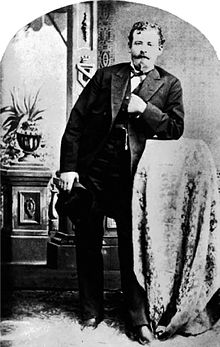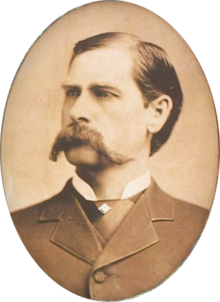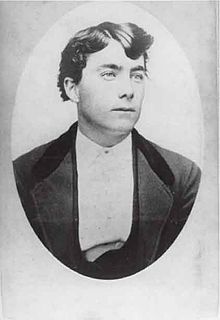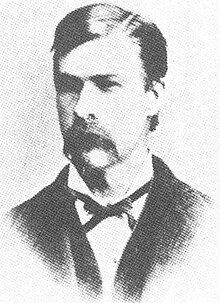Shootout at OK Corral
The OK Corral shooting was a gun battle in the Arizona Territory . It was played on October 26, 1881 around 2:30 p.m. on Fremont Street at the corner of 3rd Street in Tombstone , Arizona ( USA ). The local rental stable (corral) was later named , although this was a block away.
About 30 shots were fired in 30 seconds and three people died. The shooting served as a model for numerous Western films and is a symbol of the constant struggle between law and order on the one hand and open banditry on the other in the border towns of the Wild West , where the tensions of the Civil War continued to have an effect and where criminal prosecution is often sparse took place.
People involved
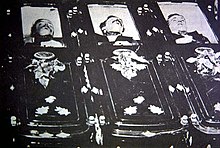
Eight people were involved in the shooting: Wyatt Earp , Morgan Earp , Virgil Earp and Doc Holliday fought Frank McLaury , Tom McLaury , Ike Clanton and Billy Clanton . Billy Claiborne was there by chance and got into the dispute as a bystander. Both McLaurys and Billy Clanton were killed, Holliday, Morgan Earp and Virgil Earp injured, Ike Clanton and Billy Claiborne escaped unharmed.
backgrounds
The brothers James, Virgil and Wyatt Earp had arrived in Tombstone with their wives on December 1, 1879. Virgil Earp had been appointed Deputy US Marshal for East Pima County shortly before his arrival in Tombstone . In June 1881 he also took over the post of marshal.
Although the Earps were not very popular (they were wealthy, owned saloons, and were known to be pimps ), they were respected because they protected the interests of the town's shopkeepers and residents. The fact that Wyatt Earp prevented Curly Bill Brocius from being lynched when he accidentally killed Marshal Fred White was less appealing to townspeople. The Earps had clashed with Frank McLaury , Tom McLaury , Billy Clanton , Ike Clanton , Johnny Ringo , "Curly Bill" Brocius, and others because they belonged to a large community of cattle smugglers and horse thieves involved in various criminal activities. Ike Clanton was also known as a drunkard and had threatened the Earps many times. Virgil Earp was convinced that the cowboys had made an oath to kill him and his brothers.
Virgil was Deputy Marshal on the day the shooting was due to take place. He had appointed his brothers Wyatt and Morgan as assistant law enforcement officers and also given police rights to his friend Doc Holliday . Silver had been found in the Tombstone area , giving the town a huge boom. Since it was founded in March 1879 to 1881, the population had risen from around 100 to over 7,000, not including Chinese, Mexicans, children and women. The economy flourished; In addition to two banks and three newspapers, there were around 110 saloons , 14 gambling houses and various brothels as well as a few mines .
Carrying of weapons was banned in Tombstone since April 1881. Knives, dirks , pistols and rifles had to be deposited in the stable or saloon when entering the city. The cowboys did not obey this law, so Virgil should confront them, which led to the shooting. The Earps were also aware that the Clantons were involved in a raid on 15 Mexicans in Skeleton Canyon .
Conflicting reports
The conflicts that led to the shooting are complex: both sides were linked by close family ties and found themselves in a conflict of interests that ranged from politics to business to ideologies. The Earps were viewed by their opponents as corrupt, badge-bearing pimps who ruthlessly advocated the city's business interests. The McLaurys, Clantons, and their cowboys were viewed by their opponents as cattle thieves, bandits, and murderers.
Contrary to what is shown in many films, the cowboy troop was by no means feared, but even popular with the Tombstone population. While many gang members were undeniably involved in cattle theft and robbery, they were just seen as wild, pleasure-seeking guys who were basically easy to get along with. Some business people even saw the cowboys as a "job security measure" because they kept the local saloons and gambling establishments running with the money they wasted and they hardly participated in illegal activities within tombstones. Although Ike Clanton was notorious for his boastful behavior under the influence of alcohol, his brother Billy was very popular. Even "Curly Bill" Brocious was by no means seen as the ruthless outlaw he was later repeatedly portrayed, but as a light-hearted, personable man who got along perfectly with the urban marshal Fred White.
The Earps and Doc Holliday are mostly portrayed as heroic guardians of the law, but this role is controversial. Indeed, according to unconfirmed statements, they were making improper use of their legitimate supremacy to strengthen their position in the city's gambling market, enforcing the law strictly on some while being very generous in ignoring offenses in others. The strong polarization of the population towards the two groups later made it difficult to clarify the question of who was ultimately to be blamed for the shooting. In addition, there were contradicting reports in the local newspapers, some of which were also driven by personal interests: John Clum, editor of the Tombstone Epitaph , had helped found a Committee of Vigilance (a kind of vigilante) shortly before the shooting , was mayor and supported Virgil Earp . Harry Woods, the editor of the other major newspaper The Daily Nugget , on the other hand, wrote more in favor of the cowboys, along with the sheriff of Cochise County .
The recordings of the hearings held after the shooting are now considered the basis of historical lore, although the reports of the two newspapers (both of which sent reporters for questioning) and the official court clerk show significant differences.
The hours before the shooting
Wyatt had sent Doc Holiday to bed the night before the shooting because he had had a heated discussion with Ike Clanton and had drunk plenty of alcohol. Virgil, on the other hand, played cards all night with Ike Clanton, Tom McLaury, Johnny Behan, and an unknown fifth man. Clanton in particular also got drunk. Towards morning the group broke up and Behan and Virgil went to bed. McLaury and Clanton hadn't rented a room and therefore had no place to stay. Ike refused to go to sleep despite a request from bartender EF Boyle, but instead threatened, according to Boyle's later testimony, with the words "as soon as the Earps show up on the street today, bullets will fall".
Ike later picked up the guns he had left in the stable and, contrary to the law, entered town again and continued to drink while he chased the Earps. At around 1 p.m. he surprisingly ran into Virgil and Morgan Earp, who disarmed him and took him to the judge. While waiting for the judge, Wyatt and Clanton cursed each other again. Ike was fined $ 25 plus legal fees and was released without a gun.
Virtually at the same time, McLaury was caught with a gun and knocked down by Wyatt. He wasn't actually allowed to search it legally because Wyatt was not on duty. In the course of the afternoon, the cowboys Billy Clanton and Frank McLaury arrived in town because they had heard that there had been trouble with the law enforcement officers there. They too did not hand in their weapons when entering the city, but bought additional ammunition. Ike wanted to buy a gun too, but because he was bandaged around his head and still drunk, the salesman refused to give him one.
Cochise County's sheriff Johnny Behan attempted to disarm the cowboys to prevent the confrontation from unfolding. Clanton and Tom claimed to be unarmed, but Frank refused to surrender his weapons unless the Earps were also disarmed beforehand.
Meanwhile, after talking to various citizens, Virgil decided, together with Holliday (for whom he had obtained a shotgun), Wyatt and Morgan, to disarm the cowboys. On the way they met Behan, whose statements Virgil interpreted in such a way that he had already disarmed the cowboys. Virgil therefore no longer expected a fight. They met the cowboys in the open space near the stable known as OK Corral.
The shooting
When the group of lawmen met the cowboys on the afternoon of October 26, 1881, Virgil is said to have immediately asked them to raise their hands and lay down their arms. He himself had left his gun in place. Instead, Frank McLaury and Billy Clanton drew their revolvers and cocked them. Virgil then yelled that he didn't want a fight. The witnesses disagree as to who started the shooting, and the statements made in the later processing were contradictory. In addition, the opponents were only a few meters apart, and the black powder used in the cartridges added to the confusion. What is certain is that around 30 shots were fired in about 30 seconds.
The first two shots were believed to have been from Wyatt Earp and Billy Clanton. Clanton aimed at Wyatt, but the latter decided to shoot Frank first, because he was considered a better shot. Wyatt hit Frank in the stomach, but Billy missed his target.
Thereupon, according to the witnesses, Holliday is said to have shot down Tom McLaury, who was hiding behind a horse, with the shotgun. Later investigations suggest that Tom was actually unarmed during the fight. At the same time, especially Frank and Billy were covered with bullets. Ike Clanton, however, fled and was unharmed. Billy Clanton and Frank McLaury continued the shooting despite being wounded. Morgan and Virgil were also wounded in the process. In the end, however, Frank was dead on the roadside, Billy and Tom succumbed to their injuries a short time later.
Public response
The bodies of the three cowboys were laid out and put on a sign saying "Murdered in the streets of Tombstone". The Daily Nugget , the cowboy-friendly newspaper, said:
“The 26th of October, 1881, will always be marked as one of the crimson days in the annals of Tombstone, a day when blood flowed as water, and human life was held as a shuttle cock, a day to be remembered as witnessing the bloodiest and deadliest street fight that has ever occurred in this place, or probably in the Territory. "
“October 26, 1881 will always be marked as one of the most brutal days in the Tombstone annals, when blood flowed like water and human life ceased to be a shuttlecock, a day that witnessed the bloodiest and deadliest street fight ever took place in this place or even in this territory. "
The Tombstone Epitaph was more cautious with the choice of words:
"The feeling among the best class of our citizens is that the Marshal was entirely justified in his efforts to disarm these men, and that being fired upon they had to defend themselves which they did most bravely."
"It seems to the best class of our citizens that the marshal was absolutely legitimized to disarm these men and when they were shot to defend themselves, which they bravely did."
The epitaph had the greater range, which is why this report predominantly shaped the opinion of the population and therefore initially developed in favor of the Earps. This view was later revised a little after it was found that both Ike Clanton and Tom McLaury were likely unarmed. Because of this, the Earps and Doc Holliday were also accused of murder instead of just enforcing the law.
examination
Four days after the shooting, Ike Clanton filed a murder charges against Doc Holliday and the Earps. Wyatt and Doc were then arrested, and Morgan and Virgil were lying in their apartments, recovering from their injuries. Justice of the peace Wells Spicer had to decide whether there should be a trial. Spicer questioned those involved and many witnesses over the course of the next month and recorded their statements. These were very contradictory, depending on which side a respondent belonged to.
On November 30, Judge Spicer ruled that there was insufficient evidence to prosecute the law enforcement officers. In particular, he viewed Frank McLaury's refusal to surrender his guns as a serious threat to the Earps. Although he criticized Virgil for having appointed his friends as deputies, he saw no violation of the law. He also ruled that their actions as a whole were covered by the law.
aftermath
Ike tried several times in the same year, unsuccessfully, to bring about a murder trial. On December 14th an attempt was made to kill John Clum, editor of the Tombstone Epitaph and mayor of Tombstone. Virgil Earp was also ambushed on December 28th. He was hit in the back, and especially in the left arm, by multiple shotgun pellets. A doctor was able to remove several pieces of bullet, but Virgil carried his left arm in a sling for the rest of his life.
Morgan Earp was sneakily shot and killed on March 18 of the following year. Two days later, Cowboy Frank Stillwell was shot dead by Wyatt in an attack on a train the Earps were on - the start of an act of revenge by the Earps against the Cowboys. Ike Clanton also fell victim to a pistol bullet a few years later. Doc Holliday died of tuberculosis in 1887 and Virgil died of pneumonia in 1905 . Wyatt Earp died as the last person involved in the shooting in 1929.
reception
Films & series
- Frontier Marshal (1939) by Allan Dwan with Randolph Scott
- Law of the Prairie (1946) by John Ford with Henry Fonda
- Two accounts (1957) by John Sturges with Burt Lancaster , Kirk Douglas and Rhonda Fleming . The original title of this film, Gunfight at the OK Corral , was a major contributor to the inaccurate but now common name of this shootout.
- Doctor Who - Episodes 115 to 118, Storyline The Gunfighters (1966)
- The Five Outlaws (1967) by John Sturges with James Garner , Jason Robards and Robert Ryan
- Starship Enterprise (Star Trek) - Episode 61 Wild West in Space (Original Specter of the Gun , 1968)
- Doc (1971) by Frank Perry with Stacy Keach
- Wyatt Earp (1994) with Kevin Costner , Dennis Quaid and Gene Hackman
- Tombstone (1993) with Kurt Russell , Bill Paxton and Val Kilmer
Books
- Lucky Luke , Volume 71, OK Corral (1997)
- Mister Blueberry , Volume 40 OK Corral (2003)
music
- The song Tombstone by the Swedish power metal band Civil War deals with the shooting.
literature
- Casey Tefertiller: Wyatt Earp: The Life Behind the Legend . John Wiley & Sons , New York 1997, ISBN 0-471-18967-7 .
- Jane Eppinga: Images of America, TOMBSTONE , Arcadia Publishing, 2003, ISBN 0-7385-2096-9 , pp. 45-49
Web links
- recovered documents Ariz. Court Discovers Original OK Corral Papers , accessed April 22, 2010
Individual evidence
- ↑ Gunfight at the OK Corral: Did Tom McLaury Have a Gun? . September 5, 2006. Retrieved February 7, 2011.
- ^ A b WGBH American Experience: Wyatt Earp, Complete Program Transcript . January 25, 2010.
- ↑ Tombstone, Arizona — Boothill . Retrieved July 29, 2016.
- ↑ a b c Testimony of Ike Clanton in the Preliminary Hearing in the Earp-Holliday Case . In: Famous Trials: The OK Corral Trial . 2005. Archived from the original on December 15, 2010. Retrieved February 6, 2011. From Turner, Alford (Ed.), The OK Corral Inquest (1992)
- ^ Testimony of RJ Campbell in the Preliminary Hearing in the Earp-Holliday Case . In: Famous Trials: The OK Corral Trial . 2005. Retrieved March 19, 2015. From Turner, Alford (Ed.), The OK Corral Inquest (1992)
- ^ Coroner's Inquest . Tombstone epitaph. October 29, 1881. Retrieved March 1, 2016.
- ^ Testimony of John Behan in the Preliminary Hearing in the Earp-Holliday Case . In: Famous Trials: The OK Corral Trial . 2005. Archived from the original on December 15, 2010. Retrieved February 7, 2011. From Turner, Alford (Ed.), The OK Corral Inquest (1992)
- ^ Testimony of Virgil Earp in the Preliminary Hearing in the Earp Case . In: Famous Trials: The OK Corral Trial . 2005. Archived from the original on February 3, 2011. Retrieved February 6, 2011. From Turner, Alford (Ed.), The OK Corral Inquest (1992)
- ^ A b Testimony of Wyatt S. Earp in the Preliminary Hearing in the Earp-Holliday Case . In: Famous Trials: The OK Corral Trial . 2005. Archived from the original on February 3, 2011. Retrieved on February 6, 2011.
- ↑ The Clanton Gang aka The Cowboys . Archived from the original on July 13, 2011. Retrieved August 6, 2016.
- ↑ Ben T. Traywick: Wyatt Earp's Thirteen Dead Men . Retrieved March 2, 2011.
- ↑ Ben T. Traywick: The Tombstone News .
- ^ Decision of Judge Wells Spicer after the Preliminary Hearing in the Earp-Holliday Case . In: Famous Trials: The OK Corral Trial . November 30, 1881. Archived from the original on December 11, 2005. Retrieved February 11, 2011. From Turner, Alford (Ed.), The OK Corral Inquest (1992)
- ↑ The McLaury Brother's Story Tombstone pt.II . Archived from the original on November 27, 2014. Retrieved February 12, 2011.
- ^ Gary L. Roberts: Doc Holliday: The Life and Legend . Wiley, J, New York, NY 2007, ISBN 978-0-470-12822-0 .
- ↑ Wyatt's House . Retrieved February 11, 2011.
- ^ Death register . Retrieved April 15, 2011.
Coordinates: 31 ° 42 ′ 50 ″ N , 110 ° 4 ′ 3 ″ W.



